
By Jason Joannides
The Columbia (SC) Fire Department (CFD) acquired structure program includes having the fire department train in the buildings of local contractors. One of my primary objectives while working with the program for the past 31/2 years was to focus on firefighter assist and search team/rapid intervention team (FAST/RIT) operations and scenarios not only because FAST/RIT scenarios are easy to set up (based on the equipment and the building) but also because it’s a hot topic in the fire service.
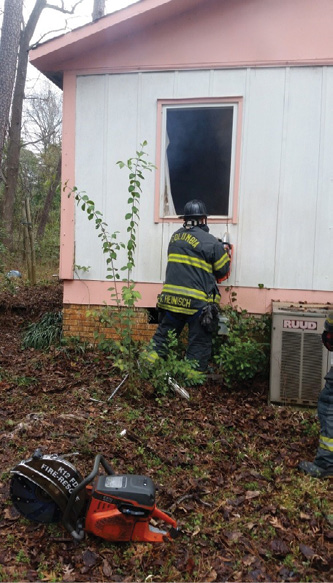
(1) This Columbia (SC) Fire Department member is using a rotary saw to complete a window-to-door conversion. (Photos by author.)
Many years ago, I, too, was a victim of the 15-to-1 super RIT kit, the hookup and pull drag with a mechanical advantage. As a young firefighter, I set out to look at easy and different ways to help rescue my brothers and sisters in a time of need. That was until I, myself, was involved in a Mayday situation. A skylight collapsed on me, pinning me to the ground during a fire. Ironically, my radio fell out of my pocket. I just lay there and watched my partner Steve Hilson unbury himself from the rubble. Luckily, he had many years on me. He called the Mayday; unburied me; and pulled me out toward the front door, where we met the RIT.
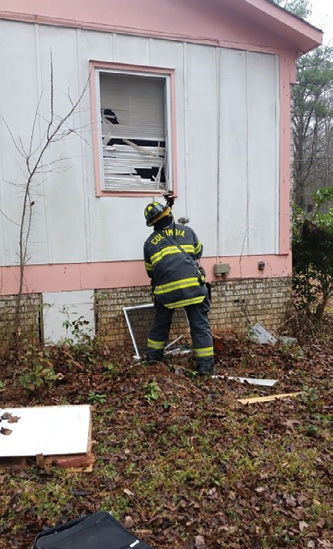
(2) This firefighter is using a hand tool to convert a window in this wood-frame house.
This article isn’t about how I survived this incident; unfortunately, everyday incidents like this, and even worse, happen. The point of this story is to allow me to show you why my lightbulb was turned on: Why do I need a super-duper webbing kit to pull someone out? What tactics and techniques are the best for our profession? When I took over the CFD’s acquired structure program, the main objectives were to determine what tools, personnel, and tactics we needed to effectively and efficiently perform rescues on down firefighters.
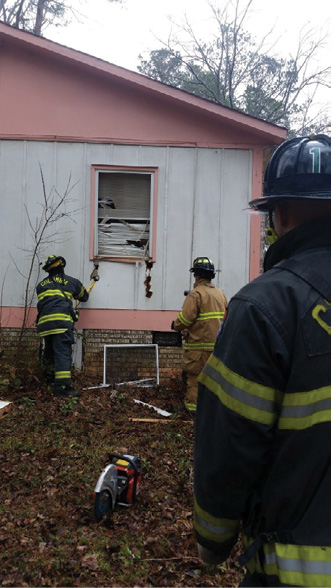
(3) A second member assists in the conversion of a window.
Rationale and Preparation
One of the main scenarios I like to run in acquired buildings is the window-to-door conversion. Basically, you have a down firefighter or even a large victim you need to get out as soon as possible. Why, as in my situation, drag the firefighter through the entire house to get out? Get the firefighter to the closest window and pull him out, especially if the window has a lower windowsill to aid in removal. Of course, you could perform a one-person victim removal, but what happens if the window was already converted to a door, or close to it? That would make a world of a difference!
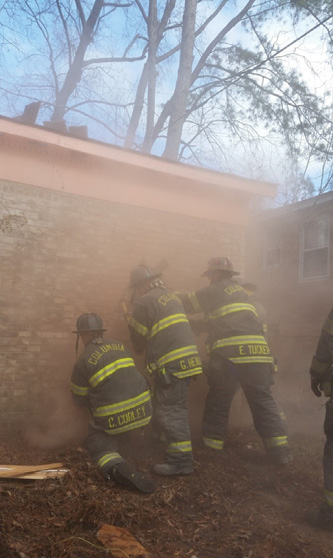
(4) Three members of Rescue 1 attempted to convert a window into a door using power tools. Because of the dust created, they stopped and switched to hand tools.
First, we must discuss the FAST/RIT. The minimum is four personnel; however, if your staffing allows it, eventually placing at least six to eight on a team is essential. Having a standard operating procedure on FAST is also imperative. Everyone on the fireground, from the probationary firefighter to the incident commander (IC), needs to know what the FAST does and who its members are. Let’s break it down.
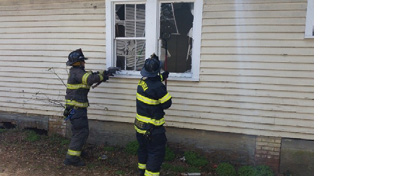
(5) Two members race to complete the window-to-door conversion. They completed it in 2 minutes, 38 seconds.
Scenario: Your department responds to a working structure fire in a single-family dwelling and two personnel are assigned to the FAST. Once they tag in with the IC, they both run a 360° size-up. The size-up is vital, as they can identify where the most hazardous operation is occurring, the fire’s location, conditions, and construction of the building. The FAST team should also set up its preassigned equipment (basic entry tools, hooks, FAST pack, search rope, saws, and stokes basket).
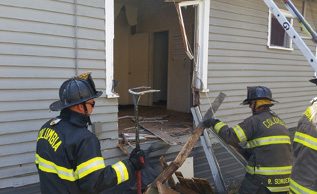
(6) If adequate personnel are available, assign them to remove the debris pile that will stack up under the window.
Most importantly, the FAST must observe the building construction before attempting a window-to-door conversion. Building construction, especially with areas that lack strict building codes, can be very surprising: Some buildings we have run into had addition on top of addition with no permit history.
During this fire operation, a Mayday is sounded, and (for discussion’s sake) say the firefighter’s crew has the down firefighter in a bedroom. The FAST grabs its equipment and heads to the closest window (previous knowledge from the size-up) and begins the window-to-door conversion. Depending on the type of structure and personnel, FAST members can access the down firefighter and remove him from the building anywhere from 2 minutes, 15 seconds to 8 minutes. Yes, that’s a big difference! Let’s discuss how we got there.
As of fall 2017, we have performed 192 window-to-door conversions within the acquired structure program. Wood, stucco, brick, and concrete buildings were all victims on the scenarios; the only variables during these experiments were the personnel and structures. The tools and techniques were coordinated throughout the study; we tried to be as consistent as possible. We used a two-, three-, and four-person FAST during the experiments since staffing levels vary among the nation’s fire departments.
Overview of the Window-to-Door Conversion
The average time of the 192 experiments from start to finish was 3 minutes, 17 seconds. That is from the time of the Mayday call, to companies making their way to the window and converting it to a door, to removing the down firefighter. The average time changed according to the building and number of personnel. Average times were as follows: two firefighters—4 minutes, 14 seconds; three firefighters—3 minutes, 2 seconds; and four firefighters—2 minutes, 38 seconds. The fastest window-to-door conversion (wood-frame house with one layer of wood and/or vinyl siding) was 2 minutes, 15 seconds with four firefighters, and the slowest was 8 minutes, 3 seconds with two firefighters (brick/concrete commercial). It is assumed that the more personnel, the less the time, but that is not always the case.
When we were experimenting with the skills, many three-firefighter teams completed the conversion more quickly than the four-firefighter teams. To efficiently and effectively complete a window-to-door conversion, you must have the skills, tools, and personnel to accomplish it. After many conversions, discussions, and much coffee table talk, the following was the most effective method for performing a window-to-door conversion, regardless of the number of personnel:
1. Remove the window/glass. Make sure the door to the room is closed for the safety of the members in the room.
2. As the window is being removed, use the back of an eight-pound ax/striking tool to hit the lower ledge (windowsill) of the window. Use the back of the striking tool so the blade of the ax does not bind in the material.
3. Have each firefighter strike the structure eight times and pass the tool to the next member. Having each member strike only eight times provides them with a work/rest cycle.
4. Continue the downward strikes (hitting the exterior siding of the building between the studs). If you have additional personnel, have them remove the debris from under the window; this will expedite the extraction of the down firefighter. (It will also lessen the chances that a firefighter doing the striking will twist an ankle or a knee while operating on the debris pile.) Remember, not all windows are the same size, but generally removing both sides of the wall will work.
5. As the structure begins to open, have one member remove the wall material by using a roof hook to pull the material outside so that it does not impede the removal process. If you have additional members inside, they can remove the interior wall material, which will expedite the process as well. Also, keep a pair of pliers nearby in case you run into electrical wires/material.
6. Once at the floor level, move all fallen debris out of the way.
7. Slide the down firefighter or victim out of the building.
This is the generalized procedure; the actual operation depends on your tooling and the building construction. Often, wood-frame homes may have aluminum, vinyl, foam insulation, or shake siding, which will increase the time and effort to cut the exterior of the building.
During testing, we found that quickly removing the siding can assist the cutting progress and prevent that material from being fed into the saw guard or blade assembly. In addition, you may run into older homes with oak planking beneath the siding that is difficult to cut. Always size up the interior as well; you don’t want to cut down a window with baseboard heat or a cast-iron radiator in front of it.
Another problem is the presence of an electrical wire in the wall beneath the window, which would hamper removal operations. This vetted procedure uses hand tools; we continuously compared hand tools with power tools. On 192 conversions, hand tools beat power tools 178 times. That’s a 92.7 percent chance that your hand tool will beat the power tool. What contributed to this astonishing conclusion?
Again, as I stated earlier, the timing began when the Mayday was called, which means you have to factor in start time for power tools. The main disadvantages we found were that when operating on wood-frame buildings, the power tools would bind up on additional material behind the siding—foam, insulation inside the wall, and carpeting. In addition, in brick structures, the dust was so heavy that it hampered the companies and necessitated that they go on self-contained breathing apparatus to finish the procedure. The average power tool time was 4 minutes, 45 seconds compared with the average hand tool time of 3 minutes, 12 seconds. The experience of the saw operator was a factor: The conversion time decreased significantly as the experience level of the saw operator increased.
The most expensive FAST kit is not going to save a down firefighter’s life. It’s the “playbook” from the start, the knowledge of what works and what doesn’t work, and when to use it. In many of the conversations I’ve had with firefighters, it was assumed that the power saws would outperform hand tools, but that is not the case. From start to finish, hand tools, technique, and a little sweat will overcome a saw 92.7 percent of the time. I know that if I needed a way out, I’d want it as quickly as possible.
Jason Joannides is a 16-year veteran of the fire service and a captain in the Columbia (SC) Fire Department Training Bureau. He manages the acquired structure program, truck company, and support schools. He previously was assigned to Ladder 7 in the North Columbia area. He is the vice president of SAFE Firefighter LLC and the Palmetto F.O.O.L.S.

